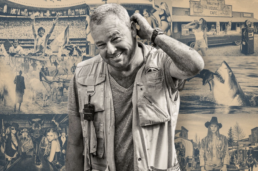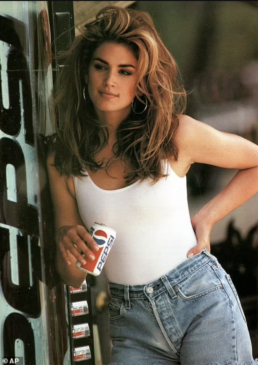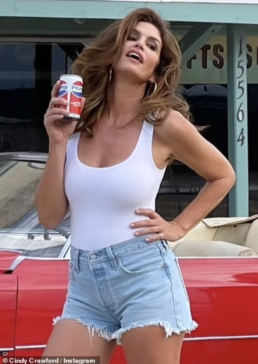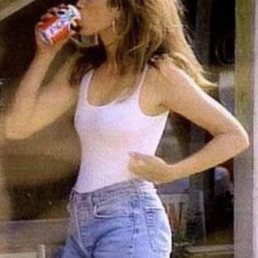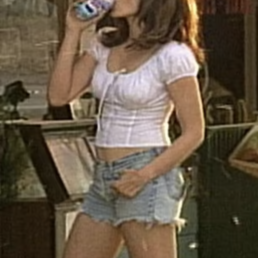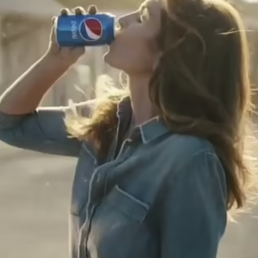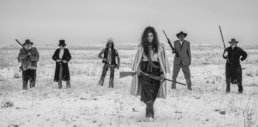David Yarrow
$90,000 a Day for One Photograph? David Yarrow Doesn’t Blink an Eye.
The British photographer, known for cinematic set pieces, discusses his iconic images, navigating art and business, and the one thing you should never call him
By Josh Sims
David Yarrow isn’t ashamed about making money — a lot of money — from his photography. And that’s for deeply personal reasons.
“One thing detractors say is ‘yeah, well, Yarrow, he’s not a photographer, he’s a businessperson,’ and that doesn’t hurt me at all, because one of the problems with the creative arts is that creatives don’t have a business mentality and that’s dangerous,” the affable, straight-talking Scot tells InsideHook. “My mum was an artist and she went bust because she didn’t care about the business side. One of my mentors says, ‘It’s not creative if it’s not commercial,’ and there’s a lot of truth in that. There’s false pride in poverty in the arts.”
Yarrow started out as a sports photographer — he took that shot of a triumphant Diego Maradona, held aloft by his teammates at the 1986 World Cup — decided he wasn’t so into it, went into banking and launched a hedge fund, and then returned to what he decided had really been his passion all along. He effectively reinvented wildlife photography, by being extremely patient and getting dangerously intimate with his subjects, and by offering a fresh, often awe-inspiring perspective that glorified his subject.
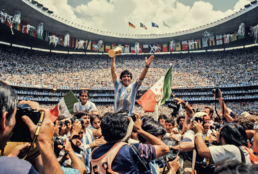
“The best pictures you can look at for a long time and show you something you haven’t seen before,” Yarrow posits. But don’t you dare call him a “wildlife photographer.”
“I think wildlife photography has become quite toxic. And if anyone [on my team] calls me a wildlife photographer, they get fired,” the 56-year-old laughs. “I remember talking to the chairman of the Tate and he told me that the one supposed art form that left him cold was wildlife photography. I asked him why and he said, ‘Because I know what a fucking giraffe looks like. I don’t need to be told what a giraffe looks like, and then to be told it’s art.’ It’s not. Go on social media every day and there are all these people on safari in Kenya with long lenses just taking pictures of leopards. That’s not art. All you’ve proven is that you’ve been able to pay to be in a beautiful place, you’ve got good camera equipment and you’ve got lucky.”
Being able to position photography as art, Yarrow says, quite upfront about it, is where the money is. Sure, he has deep affinity for the great outdoors and its inhabitants — a lot of the charity work he does with chums Chris Hemsworth and Cindy Crawford is to raise money to tackle disastrous events like the enormous bushfires in Australia in 2019 and 2020. You can’t not have an affinity for it when you’re face-to-face with a grizzly bear or a lion, he laughs, though he’s always been more worried around people than teeth and claws.
“People can do three things that animals can’t: They can get high — well, actually gorillas can get high too, but not in a bad way; they can get drunk; and they can buy guns,” he says. And that’s a very bad combination.
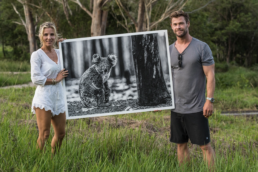
Yarrow is also very aware that his necessarily pin-sharp shots tend to work particularly well large-scale and that the people with the money to spend on art tend to have a lot of wall space to fill. Just as Jeff Bezos once said he wanted to build the most “consumer-centric” company ever, so, Yarrow jokes, he set out to be the most “wall-centric” artist ever.
Take, for example, his preference for black and white images. This is partly a product of his love of the cinema. Yarrow shoots in color but prints in black and white, because, he says, there’s a timelessness to monochrome, a reductiveness to it.
“Someone said that if you photograph people in color you see their clothes, if you do it in black and white you see their souls,” he says. But also because, in all seriousness, black and white works with anyone’s interior scheme. “Some colors are horrible to have on your wall. Yes, the monetizing is shameless,” he chuckles.
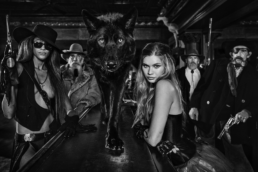
It’s just as well, since he seems to spend it as fast as he makes it. He is best known now for his monumental set pieces — essentially movie productions distilled into one frame — that can cost in the ballpark of $90,000 a day to shoot.
One of his most arresting shots, “Get the Fxxx Off My Boat,” part of a series based around The Wolf of Wall Street, involved catching multiple posed models, a popping champagne bottle and flying dollar bills on the back of a yacht. At sea. With a helicopter hovering overhead. And with, front and center, a real wolf, also posing. None of it is CGI.
That kind of expenditure really focuses the mind, Yarrow says.

“It’s not for the practitioner to call what they do art, but I did see an opportunity in that if the outside world saw my work as art then it would be willing to pay quite a lot for a picture,” he says.
He recalls taking a photograph of a shark attack in South Africa in 2011. It was printed around the world and he thought he’d finally entered the big time. When the check for all the publication rights came, it was around $17,000.
“And I calculated that it had cost me $18,500 to take the picture. So I thought, OK, this is the world’s worst industry,” he says. “But then a lawyer calling himself Jaws phoned and said he wanted a print for his office wall and I sold that one picture to him for $12,000. And that’s when the penny dropped.”
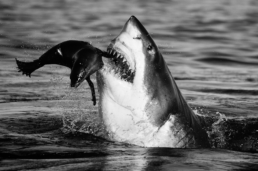
Yarrow spent the next 10 years making connections, showing his work and building a network of some 30 wholesalers around the world to sell it. It may cut against our romantic insistence that artists starve in garrets. Rather, it’s an eminently pragmatic way of getting his prints to collectors — and he now has a lot of dedicated collectors — wherever they and their blank-walled homes may be. And it allows Yarrow to focus on doing what he loves best: taking pictures.
It’s something he thinks he’s always getting better at. He has off weeks, he admits. “But I think you become a better photographer as you get older because [great] photography comes from the soul and your emotions are more mature,” he says.
Or maybe, he chuckles, “it’s just that the cameras are getting better.”
July 22, 2022
New David Yarrow exhibit 'Changing Lanes' takes over Hilton | Asmus Contemporary
DeKalb’s very own Cindy Crawford talks recreation of her famous 90s Pepsi commercial
Posted: Oct 11, 2021 / 10:23 AM CDT / Updated: Oct 11, 2021 / 10:27 AM CDT
CHICAGO — A DeKalb-native and one of the world’s biggest supermodel’s was in Chicago over the weekend.
Cindy Crawford, know for fashion, modeling, acting and lots of business enterprises — among them her infamous 1992 Super Bowl Pepsi Commercial was in Bridgeport Saturday night.
Her image in that commercial was recreated by Photographer David Yarrow to raise money for the American Family Children’s Hospital in Madison, Wisc. — where Cindy’s late brother was treated for Leukemia.
Cindy talked to WGN’s Dean Richards about her roots — and the roots of her famous commercial.
Cindy Crawford, 55, shows off her age-defying supermodel figure as she slips back into her denim hotpants to recreate her iconic 1992 Pepsi ad
Supermodel Cindy made her first appearance in a Pepsi TV commercial during the 1992 Super Bowl The original featured Cindy wearing a white tank top and blue jean shorts with big hoop earrings on She was driving a Lamborghini and then stops at a gas station for a can of soda which she sucks down And then in 2002 she was asked to appear in a very similar ad, this time for Diet Pepsi Cindy recreated the iconic ad to raise funds for the American Family Children's Hospital in Madison, where her late brother was treated for leukemia Tragically, Jeffery died of childhood leukemia when he was three-years-old
Cindy Crawford lived up to her supermodel status as she slipped back into a white tank top and her blue denim Daisy Duke shorts to recreate her iconic 1992 Pepsi Super Bowl ad.
Taking to Instagram on Tuesday, the catwalk queen, 55, showed off her age-defying figure in the photoshoot, taken by photographer David Yarrow, to raise funds for the American Family Children’s Hospital in Madison, Wisconsin, where her late brother Jeff was treated for leukemia.
Posing by a red vintage car, Cindy wowed as she once again donned silver hoop earrings and styled her hair into a big bouncy blow out.
The shoot was set at the Halfway House Cafe, where Cindy shot the famous commercial. Two wolves sat in the retro supercar as Cindy fuelled up on gas.
Crawford shared what the new Pepsi experience was like. ‘It’s always a pleasure and a thrill to work with my friend @davidyarrow,’ began the Versace model.
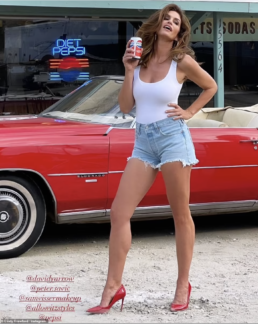
Wow: Taking to Instagram on Tuesday, the catwalk queen, 55, showed off her age-defying figure in the photoshoot, taken by photographer David Yarrow, to raise funds for the American Family Children’s Hospital in Madison, Wisconsin
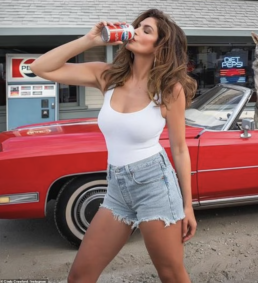
Strike a pose: Slipping into a pair of red stiletto heels, Cindy looked just as good as she did in 1992 as she displayed toned arms, long legs and very small waistline in the tiny shorts and low-scoop vest
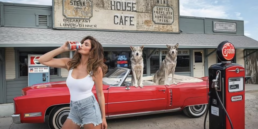
Her pack: The shoot was set at the Halfway House Cafe, where Cindy shot the famous commercial. Two wolves sat in the retro supercar as Cindy fuelled up on gas
‘And even more so when it’s for a good cause. We returned back to the original Halfway House from the famous @pepsi commercial I did in 1992 to recreate the moment (with a David Yarrow twist) in hopes of raising funds for the American Family Children’s Hospital in Madison Wisconsin where my brother was treated for leukemia.’
Crawford was born in DeKalb, Illinois, and raised with her two sisters, Chris and Danielle. Their brother Jeffery died of childhood leukemia at age three.
Cindy continued: ‘So far, with the help of David’s gallery network across the globe supporting the art and its sales — we’ve already raised 1 million dollars for the cause.’
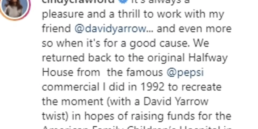

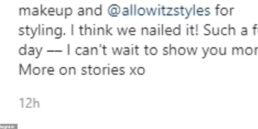
Important cause: Crawford wants to raise funds to help the hospital where her late brother Jeffery was treated for childhood leukemia. He tragically died aged three
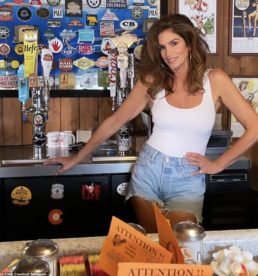
She is generous: Crawford shared what the new Pepsi experience was like. ‘It’s always a pleasure and a thrill to work with my friend @davidyarrow,’ began the Versace model
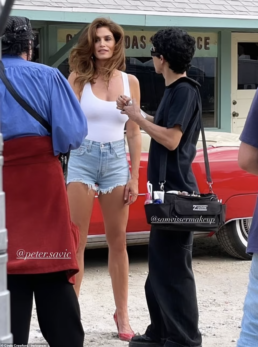
Close to her heart: ‘And even more so when it’s for a good cause. We returned back to the original Halfway House from the famous @pepsi commercial I did in 1992 to recreate the moment (with a David Yarrow twist) in hopes of raising funds’
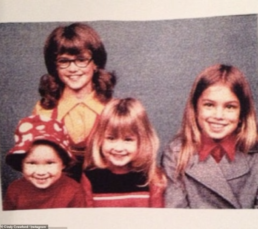
Devastating: Crawford (right) was born in DeKalb, Illinois, and raised with her two sisters, Chris and Danielle. The family tragically lost their brother Jeff when he was three
She then credited the members of her glam squad.
‘I also have to thank my dear friend, hairstylist @peter.savic who did the iconic hair for the original commercial… so i was thrilled he was able to be here for this version as well!’ said the wife of Rande Gerber.
‘Thanks also to @samvissermakeup for makeup and @allowitzstyles for styling. I think we nailed it! Such a fun day –– I can’t wait to show you more. More on stories xo.’
Stars praised her move. Reese Witherspoon said, ‘Truly gorgeous ! And for a great cause ❤️.’ Helena Christensen said, ‘❤️cool in every way.’
Thrice before: Cindy seen far left in 1992, then in another ad in 2002 and on the far right she is seen in 2018
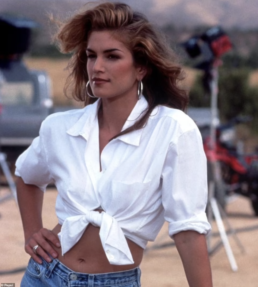
The winner? Some say that Cindy looked her very best in the original 1992 ad while others prefer a more mature Crawford
The winner? Some say that Cindy looked her very best in the original 1992 ad while others prefer a more mature Crawford
The original featured Crawford in a tank top and jean shorts – made from her own jeans she brought to the set that day – driving a Lamborghini and stopping at a rural gas station to buy a can of soda.
Two young boys in a nearby field can be seen watching on in awe and amazement as the beauty guzzles the can in one go.
‘It was one of those moments in my career that when I walked down the street, people were like, “Pepsi!” Or I’d be at a bar and people would send me over a Pepsi,’ Crawford said, laughing. ‘And it’s funny because during Halloween a lot of women will dress up as me in that commercial. It’s like an easy Halloween costume.’
In the 2018 ad she was with her son Presley Walker Gerber who was a teen at the time.
Crawford also appeared in an an ad for Diet Pepsi in 2002, where she drove to the same gas station, this time dressed in a tight white blouse and jean shorts, driving a white Jeep.
Crawford’s modeling talents have not only extended to her son – her daughter, Kaia Jordan Gerber, is also a top model.
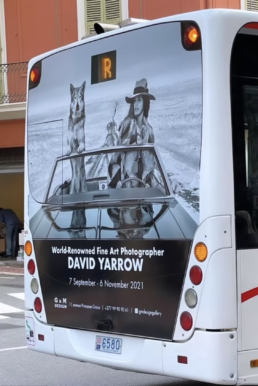
What are the symptoms of leukaemia in children?
Fatigue and pale skin – this is because leukaemia can cause anaemia which makes a child feel weak, tired and light-headed.
Infections and fever – children with leukaemia lack normal white blood cells which would normally help fight infection.
Rash – children may have small, dark spots that look like common rashes if the leukemia cells spread to the skin
Easy bruising or bleeding – this includes frequent nosebleeds, bleeding gums and bleeding a lot from small cuts.
Bone or joint pain – this is caused by a build up of leukaemia cells near the surface of the bone or inside the joint.
Swelling of the abdomen – leukaemia cells may collect in the liver and spleen causing them to enlarge.
Loss of appetite and weight loss – if the spleen and liver swell, they can press against the stomach causing loss of appetite.
Swollen lymph nodes – some leukaemias spread to the lymph nodes causing them to swell.
Source: American Cancer Society
The ad on the back of a bus: Here the ad i seen for the David Yarrow show which runs until November 6, 2021
The world in focus: David Yarrow's latest photo exhibit stars in Chicago
Majestic animals, the American West and supermodels are the highlights of a recent photography show at Chicago's Hilton|Asmus Contemporary, a gallery in Chicago.
The show “On the Road Again” stars the work of fine art photographer David Yarrow, a native of Scotland.
Yarrow’s extensive portfolio of work puts the spotlight on wildlife as well as other images of nature and humanity.
During a recent visit to Hilton | Asmus Contemporary, which is owned by Schererville resident Arica Hilton, Yarrow gave a presentation about his work to a small audience of socially distant art lovers as well as a Zoom audience from other locales. The show will be displayed through June.
Yarrow said he’s always been focused on “authenticity and originality” in what he does. His photos feature strong and dynamic images of wildlife that it’s hard to find in many other photo collections.
“I want to be the best at what I do,” said Yarrow, while speaking to the group. His “On the Road Again” display features more than 35 photos that were taken this year while he traveled through Montana, Texas and Wyoming as well as Africa and Iceland.
Many of the photos star models such as Cindy Crawford and Cara Delevingne as well as a stunning wolf-like dog breed called Tamaskan dogs.
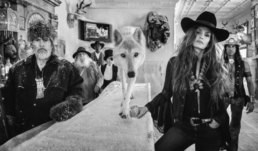
While Yarrow is a photographer by profession, he’s also a conservationist and has used his art to raise money for various charities. He said it’s important for him to “work with purpose.”
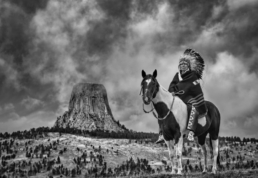
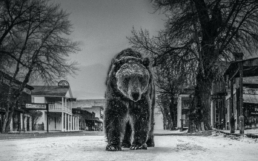
Among photos starring in the “On The Road Again” show are “Hostiles,” featuring model Crawford; “Girl on the Train,” starring model Delevingne; and “Chief,” a photo of Chief John Spotted Tail of the Lakota tribe. Yarrow said the photo of the chief is one of his personal favorites. “This is exactly how he should be photographed,” Yarrow said about the photo which features the Chief in full Native dress atop a regal horse.
About the process of photographing, Yarrow said he’s persistent.
“I’m all about patience and never quitting. You must never quit,” he said. That attitude is especially helpful in photographing his various wildlife subjects. The photographer said he prefers using wide-angle lenses in his work and also photographs in black-and-white.
The current Yarrow show features photographs that the public hasn’t been exposed to before.
“These pictures haven’t been seen anywhere in the world yet. And some were taken three or four weeks ago,” Yarrow said adding that he was happy to debut them in Chicago.
“We love Chicago. That’s why we keep coming back,” he said.
Written By | Eloise Marie Valadez
Photographer David Yarrow on the Inspiration Behind His New ‘Wild West’ Series Starring Cindy Crawford and Cara Delevingne
Yarrow traveled to Montana and Wyoming to create these quintessentially American images.
British photographer and conservationist David Yarrow is celebrated for his black-and-white photos of far-flung territories, endangered landscapes, and nature’s most majestic creatures. This fall, after a long quarantine, the photographer set off for Wyoming and Montana to shoot his new series “The Wild West.” Headlined by supermodels Cindy Crawford and Cara Delevingne, the series captures quintessentially American scenes from the cross-country road trip, which culminated at a Western saloon. “The Wild West” series also features Chief John Spotted Tail, of the Lakota tribe, who appears self-styled in his images.
The new images—along with many of Yarrow’s iconic works from earlier series—are currently on view at Chicago’s Hilton | Asmus Contemporary. A portion of the profits from sales will be go to benefit charities and organizations supported by Yarrow and his models.
Below, Yarrow shares his inspiration behind a few of his new photographs:

“We have all, at one time or another, entered a bar, and immediately felt out of place. At the most extreme level this can evoke a sense of trespassing. This was very much the narrative behind this photograph. To be greeted by an overtly territorial crew with menace and attitude. But, for the story to work, two things had to coalesce as—the characters and the interior. I like playing with the cold, it adds a visceral layer to the story and in this case, it hints at an outpost on the final frontier. Surely the further off the beaten track we travel, the greater the chance of being the outsider. This is a frame that exhausts every inch available in the camera and that was my intent. There were so many characters I wanted to include, but I was also reluctant to lose the mood of the frozen saloon…. Our key asset was, of course, Cindy Crawford, and she had to have sovereignty of the joint. She can play a badass very well and that was her ascribed role.”
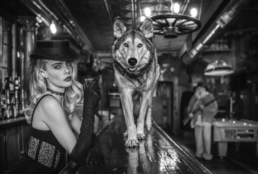
“The Pioneer bar in Virginia City has offered so much to us over the years and we are acutely conscious not to overplay our hand here. After all, there are many other weathered saloons in the West. We don’t want to be repetitive in our story telling…The Pioneer is emphatically the best bar known to us. It has depth and the wagon wheel on the ceiling is ideally positioned. To bring such a celebrated and relevant woman as Cara to Montana is fresh ground. Put her in front of the Eiffel Tower and it is a new look on the Eiffel Tower. I can’t think of any other woman in the world I would prefer to play this role. These are not easy images to execute as there is such limited light. Depth of field and shutter speeds are therefore compromised. Cara would always be sharp—that was easy—then we had to hope for some luck elsewhere. Cameras have improved so much over the years in terms of ability to work in low light. I could not have done this 10 years ago. But you are pushing the camera right to the edge of its capability.”

“Once we found the caterpillar road that dissects this picture, I knew that we had the canvas on which to continue our road series that started in 2018… The only traffic was the occasional oil worker or perhaps someone who was totally lost… The sense of place is palpable. This is the America that so many know and love, with its long roads running to the horizon with either side exuding a simple sense of calm and solitude. No other country in the world offers road trips as visually rewarding as America and they are integral to the fabric of the American dream. The snowfall the previous night added another layer to the narrative both on the road itself and on the prairies. We were lucky that the snow stopped and the light picked up. It adds warmth to an image already glowing with positivity and joy. Willie Nelson was surely singing “On the Road Again” on the car radio with the volume turned up to the maximum level.”

“The senior Elder of the fabled Lakota tribe is Chief John Spotted Tail. We spent two days with him in northern Wyoming and he was so excited to wear the headpiece that only the most senior Native American chiefs like him can wear. His attire was emphatically his decision, not ours. Their heritage is integral to their souls. The ground in front of Devils Tower has film history. It is, of course, where Spielberg shot Close Encounters of a Third Kind immediately after the release of Jaws in 1975. More poignantly, it is sacred land for Native Americans, and, at dawn, before our early morning shoot, John and his wife, Tamara Stands and Looks Back, spent some time there praying. At around 8:30 am, the low hanging clouds lifted above the iconic geographical landmark and shafts of light lit up our canvas. We had our moment. Later that day, when I showed Chief John Spotted Tail this image, he shed a tear and I am proud to admit I did too. It was one of the most privileged days I have ever had in the field.”
David Yarrow’s “The Wild West” series is on view at Hilton| Asmus Contemporary through June 2021.
Written By | Artnet

